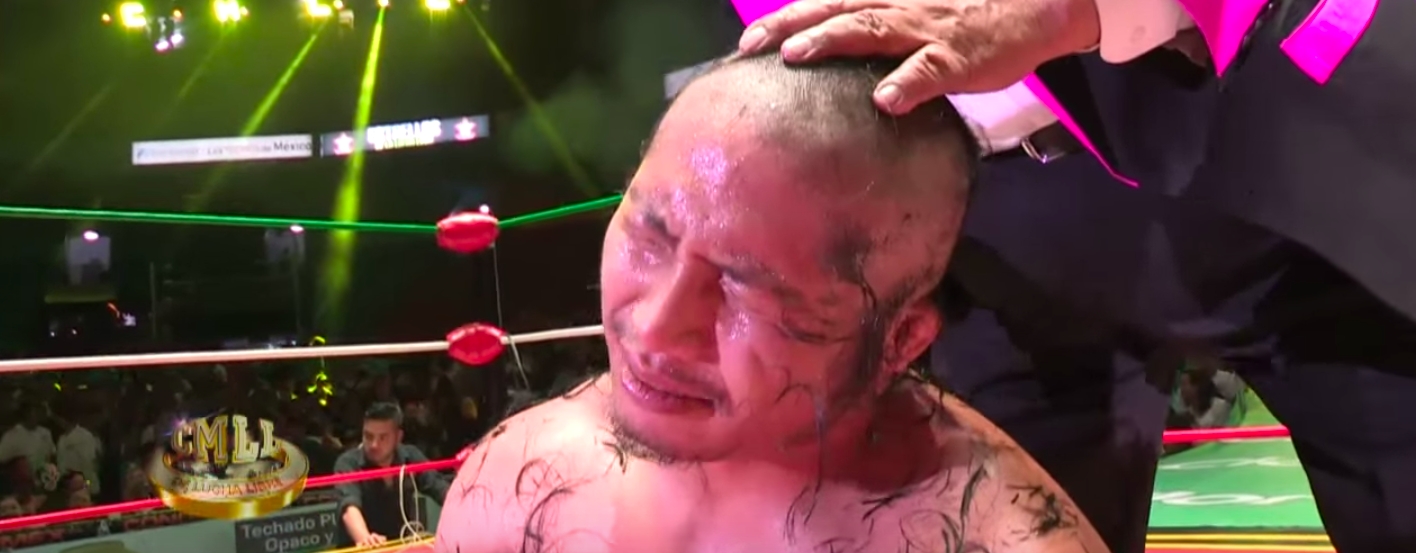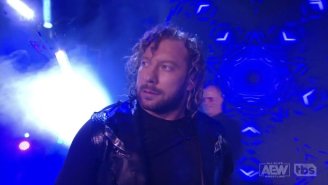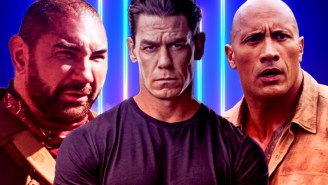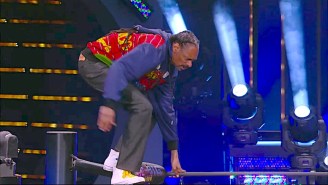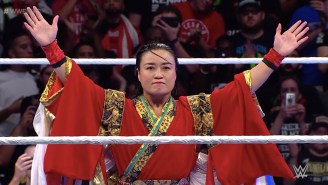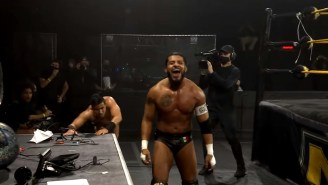Previously on Job Opportunities, Brandon looked back at current wrestling stars’ times as jobbers in WWE and WCW and I wrote about the closest thing most New Japan Pro Wrestling stars have to time spent working as enhancement talent: their early careers as perpetually-losing Young Lions. While I was writing that article, I realized it had a natural sequel. In the U.S., wrestlers are often booked as jobbers before they have it all put together, at least the version of “it” for which they become known. In Japan, many wrestlers travel overseas for learning excursions before returning to their home promotions as, if not their final form, an evolved and leveled-up version of themselves.
There isn’t a set amount of time that these wrestlers will be gone; New Japan wrestlers have spent between a couple of months and a couple of years on excursion before returning to the King of Sports. While working outside of New Japan, these young men have opportunities to experiment with their wrestling styles and personas, to work in front of new audiences, and, considering most join the dojo right after high school or college, probably gain some valuable life experience.
Wrestlers don’t only go abroad right after graduating the dojo, though. Some leave for a while to reset and figure things out when they’ve hit ruts in their careers or feel like they need a change, something that New Japan fans most recently saw Hirooki Goto do as part of a storyline earlier this year.
With all that in mind, here’s the New Japan Pro Wrestlers On Excursion edition of Job Opportunities, looking back at how some NJPW stars of the present and past evolved while working overseas.
No Limit
https://www.youtube.com/watch?v=8QVhU614yaE
After debuting in 2004 and 2005, Yujiro Takahashi and Tetsuya Naito got their first major pushes as a tag team called No Limit. The team formed and won the IWGP Junior Heavyweight Tag Team Championship in 2008, then lost it to The Motor City Machine Guns at Wrestle Kingdom III in January 2009. The next month, No Limit won a match to earn the right meet the MCMG on their home turf, TNA, and challenge for the junior tag titles. They never won those belts back, but Naito and Yujiro (as they were billed in the U.S.) did stay in TNA for a few months on a learning excursion. They were depicted as pretty standard Foreign Heels and sometimes teamed up with other Asian wrestlers.
The duo then took their excursion to CMLL in Mexico, where they spent a longer period of time working as anti-Mexican heels. Naito and Yujiro were part of the stable La Ola Amarilla (The Yellow Wave) led by Okumura, a Japanese wrestler who’s lived in Mexico for years, typically teams up with visiting Japanese talent, and plays a behind-the-scenes role in the NJPW-CMLL-ROH relationship. Naito and Yujiro left CMLL after losing a hair vs. hair match in December 2009 and soon returned to NJPW as short-haired heavyweights to win the IWGP Heavyweight Tag Team Championship at Wrestle Kingdom IV.
No Limit’s time in CMLL impacted them beyond giving them a reason to move up weight classes. It’s probably when Takahashi got the taste for good Mexican salsa that he told Uproxx he can’t find back home, and, more significantly, it’s when Naito developed his signature eye taunt. The official name of when Naito holds one of his eyes open with his fingers is “Abre Los Ojos” (Open Your Eyes) and he started doing it in response to racist things yelled at him by wrestling fans in Mexico, turning insults into trolling, something that would fit well with the persona he developed in the 2010s.
Tetsuya Naito
A few years later, Tetsuya Naito returned to CMLL for another excursion, one that would lead to significant changes in his career and in New Japan. After breaking out as a singles wrestler, turning face in the No Limit split, and taking eight months off to recover from knee surgery in 2012, Naito was set up to achieve big things. As the babyface “Stardust Genius,” he won the 2013 G1 Climax tournament and was set to challenge Kazuchika Okada for the IWGP Heavyweight Championship in the main event of Wrestle Kingdom 8. But his push was so unpopular that New Japan ran a fan poll to determine whether Naito vs. Okada or the Intercontinental Championship match between Hiroshi Tanahashi vs. Shinsuke Nakamura should main event their biggest show of the year, and Tanahashi-Nakamura won.
Naito didn’t win the Heavyweight Championship on January 4, 2014, and his New Japan career continued in an odd state. He was a great wrestler but had been proven not to be fan-favorite or, in the audience’s minds, a top guy. But when Naito went back to Mexico and broke bad, his career changed for the better. After Global Wars 2015, Naito returned to CMLL. La Sombra (now WWE’s Andrade), who had tagged with Naito while working in NJPW, was now part of the cool heel stable Los Ingobernables, and he invited Naito to join the group.
When Naito returned in NJPW, he was all about the tranquilo lifestyle and very much not about being governed. He didn’t react to anything, trolled everyone, had a mean streak, cheated, and started building his own chapter of the stable that turned his life around, Los Ingobernables de Japon. Now, a few years later, L.I.J. is the most popular faction in NJPW and Naito has grown from hated babyface to heel you love to hate to beloved antihero and one of the most popular wrestlers in Japan.
Hiromu Takahashi
Our still sadly out of action Hiromu Takahashi is another NJPW star who had a very significant CMLL excursion. When Takahashi worked in CMLL from 2014-2016 under the name Kamaitachi, a creature from Japanese mythology, he found himself as a wrestler and found his greatest rival. In 2015, he started feuding with basically his wrestling soulmate in Dragon Lee. Kamaitachi lost his match to the luchador, who has since brought it to New Japan several times for matches against and in honor of Takahashi.
Takahashi also lost his hair in Mexico and spent some time in Ring of Honor and on the American indies before returning to his home promotion, but the most important part of his work abroad was clearly the rivalry with Lee. They put on crazy matches every time they were in the ring together, facing off multiple times in CMLL and in NJPW before Takahashi sustained a serious neck injury while defending his IWGP Junior Heavyweight Championship against the luchador in July 2018.
Lee and Takahashi have continued to interact on social media and tease future matches, with Dragon Lee frequently referencing Takahashi while he was IWGP Junior Heavyweight Champion earlier this year. But the chances of them ever wrestling again was further complicated when Lee was recently fired from CMLL after his brother Rush quit the company.
Whether these two ever face each other again, their rivalry that started while Takahashi was on excursion in CMLL has already been important for both of them. Dragon Lee and Hiromu Takahashi’s rivalry entertained fans and helped raise their profiles in the wrestling world.
Evil
Fresh out of the New Japan dojo, Takaaki Watanabe made his Ring of Honor debut in the May 2014 Four Corner Survival dark match above, facing Caprice Coleman, Matt Taven, and Silas Young. His vest with the Lion Mark logo on the back could be charitably described as proto-goth, but he really doesn’t look like a future King of Darkness at all, just like a nice, normal dude.
Watanabe looks and sounds a lot more like Evil by August 2015, though, when this promo was recorded, with a hairstyle and tone of voice are similar to those that are part of his act today. Soon after this promo, he had the highest-profile match of his ROH excursion, an unsuccessful challenge for Jay Lethal’s World Television Title. He returned to New Japan at King of Pro Wrestling in October 2015, the man who used to be a friendly-looking dojo boy now “Evil,” the third member of Los Ingobernables de Japon.
Sanada
Continuing this article’s L.I.J. streak, check out TNA Sanada! While working in Japanese independent promotion Wrestle-1, Seiya Sanada beat Austin Aries for the X Division Championship in March 2014. He showed up on TNA’s Lockdown pay-per-view a week later alongside his mentor, The Great Muta, kicking off a year-long stint with the company that wasn’t really an excursion, but ended up playing a similar type of transitional role in his career.
As X Division champ, Sanada feuded with Tigre Uno and wore blue gear and a haircut a lot like the Fashion Space Pirate look he switched to from Mohawk Goth earlier this year. After he turned on Muta, he adopted a new Muta-like persona, The Great Sanada, which you can see in the video above.
Sanada left TNA in April 2015 and worked on the indies, performed for Global Force Wrestling for a hot second, and participated in a WWE tryout in Japan. In April 2016, he ended up in NJPW with a new look and L.I.J. membership, making his debut in the company he had first tried out for eleven years previously. Sanada’s intention may have been to continue working in the U.S., but like a learning excursion, this period overseas ended up setting him up for bigger things back in Japan instead.
Shingo Takagi
Long before he debuted in New Japan the newest member of L.I.J., Shingo Takagi was sent on an excursion to the U.S. by his home promotion, Dragon Gate. Takagi became the first graduate of the Dragon Gate dojo when he debuted in 2004 and soon started making appearances for PWG and Ring of Honor, American indies with which Dragon Gate had a relationship. Takagi lived in the States and worked for ROH regularly in 2006 and 2007 and got a few high-profile matches out of the deal, holding the ROH World Tag Team Championships with Naruki Doi for a while and, in the last match of his excursion, unsuccessfully challenging Takeshi Morishima for the ROH World Championship.
While working for ROH, the twenty-four-year-old Takagi dropped his surname from his ring name and started being billed as just “SHINGO” while working outside of Japan and grew and then shaved off an awkward mustache. According to Excalibur, this was also when Takagi started making Japanese pride part of his wrestling character, while “before that he was just sort of a muscle guy.” It was on excursion that he named his finisher “Made in Japan” and the move name and national pride aspect of his persona stuck beyond that, through heel and face iterations, to the present day.
(Shoutout/thanks to Fanbyte wrestling editor lb hunktears for asking Excalibur the questions whose answers were used in this section.)
Taichi
New Japan’s Holy Emperor Taichi started his career in 2002 in All Japan and made his first international performance for TNA. In June 2004 on NWA-TNA PPV #96, Taichi wrestled his first ladder match as part of the 2004 World X Cup. He was only sixteen months into his wrestling career and looked it. His biggest spot in the match was when he awkwardly tried to use a ladder as a weapon while wearing it and was shoved in the corner by Eric Young.
After a period as a freelancer, Taichi joined the New Japan roster in 2009, and was sent on excursion to CMLL the following year in order to figure himself out after his tag partner, Milano Collection A.T., retired. One of Taichi’s most notable matches in Mexico was a hair vs. hair two-out-of-three falls bout against Máximo. In the battle between the former sidekick of an Italian fashion model character and an exótico, the Mexican wrestler came out on top, and Taichi’s long blonde locks were shaved off. The memory of this match lives on not just through the above highlights video on CMLL’s YouTube channel, but in Tijuana’s Museo de la Lucha Libre, where Taichi’s hair is part of an exhibit of hair wrestlers have lost in luchas de apuestas.
El Desperado
https://www.youtube.com/watch?v=D7DZwDzIZzY
The other NJPW wrestler (and current member of Suzukigun) whose hair is behind glass at the Tijuana lucha libre museum is El Desperado. His excursion CMLL was the first time New Japan dojo grad Kyosuke Mikami donned a mask. He played Namajague, a persona based on a demon from Japanese folklore and a character he brought back for the most recent NJPW-CMLL Fantastica Mania tour, with the gimmick was that Despy had gone on a trip to Mexico and this Japanese luchador had come over with the CMLL guys.
Namajague was unmasked in March 2013 and lost his hair the next month. His return to New Japan was never officially announced, but when a new masked wrestler, El Desperado, showed up at Wrestle Kingdom 8 in January 2014, fans could easily figure out he was Mikami. Though he wasn’t literally “hecho en Mexico” like some of his shirts say, El Desperado’s character basically was.
Hiroshi Tanahashi and Shinsuke Nakamura
Hiroshi Tanahashi and Shinsuke Nakamura went on excursion to CMLL together in 2005 while they were IWGP Tag Team Champions, during one of the brief periods they were not arch enemies. In his 2014 autobiography, King of Strong Style, Nakamura said that the company’s initial plan was for only Tanahashi to go to Mexico, but he asked to go along too because he wanted to work on his wrestling style. He had wrestled overseas before, training briefly in Antonio Inoki’s LA Dojo in the early 2000s and touring with New Japan in other countries, but he thought his style of wrestling, which was very serious and MMA-esque at the time, “didn’t make sense overseas.”
In Mexico, Nakamura said he learned “to sell your own self, to have fun in different environments. Perform your role in the match, but do it with little tricks and tweaks so you yourself have fun with it.” Working in Mexico wasn’t all fun though. Nakamura was a rudo (a heel), so “outside of Arena Mexico, I regularly had lit cigarettes pressed into my back or drinks thrown at me. I got leftover chicken bones and some kind of mystery liquid thrown at me too.”
King of Strong Style
https://www.youtube.com/watch?v=rtjH9No5MUo
Shinsuke Nakamura went through a more obvious evolution when he returned to CMLL on his own in 2011. At this point, he had been one of New Japan’s top guys for years, was the leader of the Chaos faction, and had started the King of Strong Style gimmick, but he was still putting together the pieces of what would be his persona for the remainder of the decade.
According to his autobiography, he had been working on changing up his wrestling style in Japan and wanted to work to Mexico again because he saw it as a place where he would have the freedom to try out new things. “I wanted an opportunity to just change all kinds of things all at once, including my own feelings… I crushed everything that had been in me up to that point, those ideas of ‘You can’t do this, you can’t do that.’ I was just trying whatever I felt like doing. I’m sure I had my mind set on smashing whatever prejudices I had in my head, and I really wanted to find a free space, mentally, in Mexico.”
He tried out a mohawk, then shaved it off, but other experiments stuck: “I was wearing these red motorcycle pants and trying out these unprecedented moves, and the promoter at CMLL got mad at me. I mean, he was probably like, ‘I thought New Japan’s Nakamura was coming, but you’re like another person!'”
Though he took his experimentation too far for CMLL officials’ tastes at some points, Nakamura’s evolution in Mexico still worked out. By the time he returned to New Japan to win the G1 Climax for the first time that summer, Nakamura had changed his entrance from a fairly straightforward walk to the ring, dressed in all black, to weirder, more “weaving” movements made more dramatic by new red, Michael Jackson-influenced gear and the shorter version of the hairstyle he still has today.
Nakamura described the evolution in his book, saying, “This trip to Mexico refreshed me, like there was something in me that popped open. And then when I went home, the visuals of Shinsuke Nakamura were totally different, and the fans’ shock was a lovely thing to experience. I’m sure they were also like, ‘Nakamura spent too long under the Mexican sun and lost his mind.'”
Like the MMA-influenced Super Rookie had in the early 2000s, this version of Nakamura, a more flamboyant character and obvious showman, fit well at the top of the 2010s version of New Japan, a promotion with distinctive, dramatic characters.
Kazuchika Okada
https://www.youtube.com/watch?v=VcUH2FDzRSA
Some excursions go better than others, and Okada‘s in TNA infamously went so poorly that it ended the relationship between New Japan and the company that is now Impact Wrestling. After Okada debuted for TNA in February 2010, he wrestled dark matches until he made his “webmatch” debut in the match above. Aside from one match on Impact!, he appeared on Xplosion until January 2011, when he began the more well-known portion of his TNA career.
https://www.youtube.com/watch?v=Kpb6TPJYI00
Okada’s ring name was changed to “Okato” and he started dressing as a driver and playing Samoa Joe’s sidekick in a feud with D’Angelo Dinero. A parody of Kato, Bruce Lee’s character from the 1960s TV show The Green Hornet, was managed to be both very retro in a bad way and a timely reference because the Green Hornet movie starring Seth Rogen and Jay Chou came out that same month. Mostly, this was a baffling choice of how to handle a young wrestler who was earmarked to be extremely important in his home promotion, especially since the Okato period was the most notable part of the almost two years Okada spent in TNA.
But Okada later said he did get something out of his American excursion: he learned that he needed a character. When he returned to New Japan Pro Wrestling at Wrestle Kingdom VI, he had one. With a flashy coat and dyed-blonde hair, the 24-year-old dubbed himself “The Rainmaker” and claimed he would make it rain money in New Japan, something that literally started happening as part of his entrance. In a massive upset, he defeated Hiroshi Tanahashi to win the IWGP Heavyweight Championship at The New Beginning 2012 and has been a top guy in New Japan ever since, and has pretty much delivered on that whole moneymaking promise-brag.
The Great Muta
Keiji Mutoh’s excursions are an interesting case because, while those of more recent New Japan stars have gone under the radar for a lot of wrestling fans, this small portion of Mutoh’s career is what a lot of people who would read articles about wrestling in English on the internet are most familiar with. His work abroad not only stuck in the minds of people watching the NWA and WCW in the late 1980s and the 1990s, but saw him make dramatic creative developments that he then incorporated into his NJPW career and that have influenced many other wrestlers since.
A martial artist and student of the New Japan dojo, Mutoh made his pro wrestling debut in 1984 and went on his first learning excursion to the U.S. in 1985. He wrestled mostly in Florida as “White Ninja” and returned to NJPW in 1986 a little weirder, with a 1960s haircut, space-age jacket, and nickname “Space Lone Wolf.”
Though Space Lone Wolf is an extremely good nickname, it was far from Mutoh’s final form. He took another excursion abroad in 1988, working for Puerto Rico’s World Wrestling Council. He used the ring name “Super Black Ninja” for this period, which included this cool street fight against Invader #1 and produced this extremely good video package that has inter-dimensional energy.
Mutoh later returned to the continental U.S. and began the most well-known period of his American wrestling career. He started wrestling for the NWA and appeared on WCW Saturday Night from 1989-1990, a period that included feuds with the likes of Sting and Lex Luger, an NWA Television Championship reign, and the debut of his Great Muta persona. When Mutoh returned to Japan, now with both human and demon versions of his persona, he quickly became a huge deal.
New Japan has several young wrestlers out on excursion right now: Hirai Kawato as Kawaton-san in CMLL and Tomoyuki Oka (as The Great O-Kharn) and Hikuelo in the UK, with Shota Umino headed to the UK as well and Ren Narita to the New Japan’s LA Dojo. Though it’s easy for fans to follow their journeys if they want in the age of internet streaming, what they’ll do when they get back to NJPW is unknown. Judging from past New Japan excursions though, they’ll probably have changed-up personas, more opportunities to advance, and almost definitely won’t have to have to job as much anymore.

